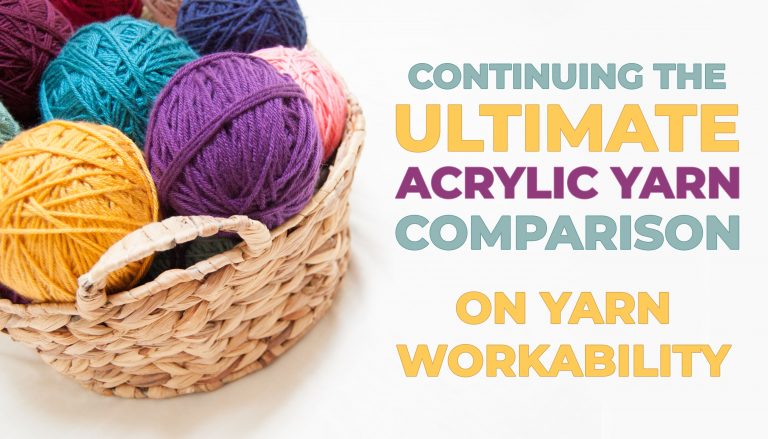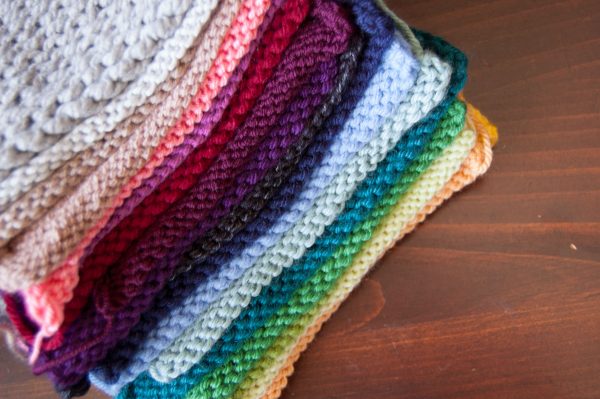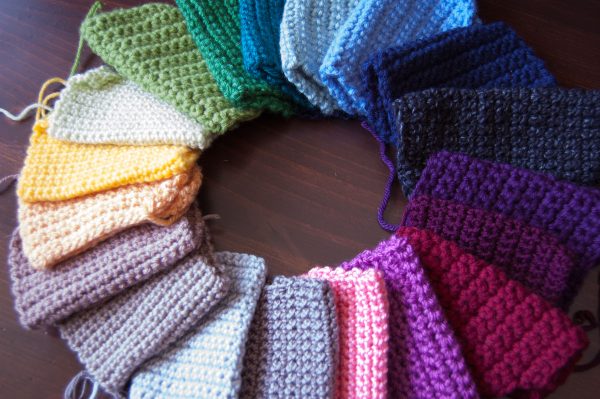 Yarn Workability – Ultimate Acrylic Yarn Comparison
Yarn Workability – Ultimate Acrylic Yarn ComparisonYarn Workability – Ultimate Acrylic Yarn Comparison
Today’s exciting installment of The Ultimate Acrylic Yarn Comparison will cover yarn workability! In this post, I’ll address both the ease of knitting and the ease of crocheting with all these yarns. Because believe it or not, yarns do not always behave the same for knitting as they do for crochet!
I have two videos in the post, one going over the yarns in knitting and one in crochet. But don’t just watch the videos and ignore my commentary because I’ve got lots of additional thoughts that are NOT in the videos. And generally my writing is more coherent.
The Best Yarns for Knitting
In this video I try to highlight what yarns I enjoyed working with versus the ones I didn’t. But I also tried to objectively distinguish them based on things like splitting and squeaking.
To summarize, the yarns I truly enjoyed knitting: Premier Yarns Everyday Anti-Pilling Worsted, Loops & Threads Joy DK, Schachenmayr Soft & Easy, King Cole Cherished DK, KC (Knit & Crochet) Smooth, Hobby Lobby I Love This Yarn, Lion Brand Jeans, Willow Yarns Wash, Caron Simply Soft
Versus the yarns I enjoyed working with the least (because of stiffness, splitting or squeaking): Red Heart Soft, Knit Picks Brava Sport, Bernat Softee Chunky, Caron One Pound, Loops & Threads Impeccable
And the yarns that were just fine one way or another: Big Twist Value Yarn, Lion Brand Basic Stitch Premium, Lion Brand Basic Stitch Anti-Pilling, Cascade Yarns North Shore, Stylecraft Special DK, Paintbox Simply DK
The Best Yarns for Crocheting
I may mention a few things about knitting in this video, but I focus on crochet workability here. There were yarns that crocheted better than they knit and vice versa!
To summarize: Overall, I found that my opinions were not quite as strong when it came to crocheting these yarns. To compensate, I have made these lists a little more granular (yarns may appear in more than one list):
Yarns I REALLY enjoyed crocheting: Lion Brand Basic Stitch Premium, Lion Brand Basic Stitch Anti-Pilling, Premier Yarns Everyday Anti-Pilling Worsted, Loops & Threads Joy DK, Willow Yarns Wash
Stiff Yarns: Loops & Threads Impeccable, Caron One Pound, Bernat Softee Chunky
Slightly Splitty Yarns: Caron Simply Soft, Red Heart Soft, King Cole Cherished DK
Yarns prone to squeaking: Red Heart Soft, Knit Picks Brava Sport, Loops & Threads Impeccable
Everything else: Big Twist Value Yarn, Hobby Lobby I Love This Yarn, Lion Brand Jeans, Paintbox Simply DK, Stylecraft Special DK, Cascade Yarns North Shore, KC (Knit & Crochet) Smooth & Schachenmayr Soft & Easy
Swatching Can Teach ALOT About Yarn
I spent ALOT of time swatching for this project. Like an absurd amount. If you haven’t followed any of my other posts in this series, I’ll fill you in quickly. For every yarn, I knit one swatch. Frogged it. Crocheted the same length of yarn. Frogged it AGAIN before doing one final knit.

I did this because I wanted to identify how well a yarn would hold up to frogging. And as I continued to work swatch after swatch, I had new thoughts on workability that I didn’t expect.
So if you have a few more minutes to spare, let me share my “revelations”.
First Revelation: Dealing with Squeaky Yarn
I learned that the dreaded “squeaky” yarn is VERY real, but it doesn’t have to be the end of the world. You may find recommendations online for running the needle through your hair or oiling it, but neither of these worked for me. What did work was waxing the needles with a dryer sheet, but the effects were not permanent. On yarns that were very prone to squeaking, I had to repeat this treatment as soon as every few rows.
Additionally, the types of needles/hooks you use make a difference. My aluminum knitting needles squeaked worse than my stainless steel needles. But my bamboo needles squeaked the least of all! If you only work with acrylic yarn and can handle the extra friction, avoiding metal needles will really help with this problem. 🙂 The same should apply to crochet hooks. I only have aluminum hooks so I cannot say for sure, but going wood should help here too.
Second Revelation: Dealing with Splitty Yarn

Although there are yarns that split no matter what, your needle makes a huge difference with splitting too! Yes, both in knitting and crochet.
When knitting, yarns I knit with my pointed tip Chiaogoo needles often split less than when knitting the same yarn on my blunter aluminum needles. But this was not always the case! Some yarns worked nicer on the blunter tips.
For crochet, the head of your hook also makes a difference! When buying knitting needles, you’ll typically encounter one of two types of heads. One is more rounded at both the tip and around the sides of the hook (the Boye type hook). The other has a more pointed tip with flat, inline sides to the hook (the Bates type).
I grew up using Bates type hooks. I still have them, but my husband bought me a set of Boye type hooks. Trust me, they are different! I personally think the Boye type is more prone to splitting when entering into a stitch; whereas the Bates hook is more likely to split the yarn when pulling it through a stitch. The point is: if you feel like a yarn is being super splitty, try the other hook type and see if that helps! There are incredibly affordable sets in each type on Amazon, and I personally think it is worth the investment to have both kinds.
Final Revelation: Managing Yarn Stiffness
I found that hand fatigue from stiff yarns is not as bad when working with wood needles. Although I still have to fully test this theory, I noticed a significant difference with Loops & Threads Impeccable. I made a baby sweater in this yarn and knit the body in the round on my stainless needles. The sleeves were knit on wood double points, and BOY did the sleeves go easier on my hands than the body.
Final Thoughts on Workability
While there will always be “bad yarn” out there, take most of these accusations (including my own) with a grain of salt. There are things you can do as a maker to utilize a yarns traits to your advantage (example: stiff yarn = amigurumi yarn). And there are some nice hacks out there for solving common complaints.
After doing a yarn workability comparison for myself, I’m no longer afraid of blanket statements like “Caron yarn is splitty”. In fact, the list of yarns I am now able and willing to purchase is much larger! I used to avoid Michael’s sales on Red Heart and Caron because I remembered disliking the yarns so much when I was younger. But now I know that I can happily knit 90% of yarns with the right tools.
If you found this post helpful, please consider supporting my blog by buying yarn through one of the affiliate links below or by buying me a coffee on Ko-Fi!




